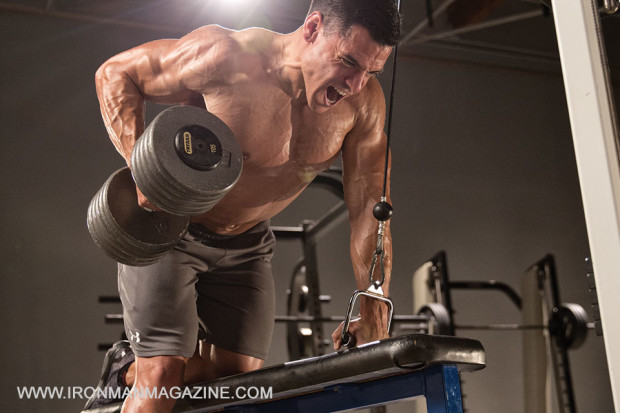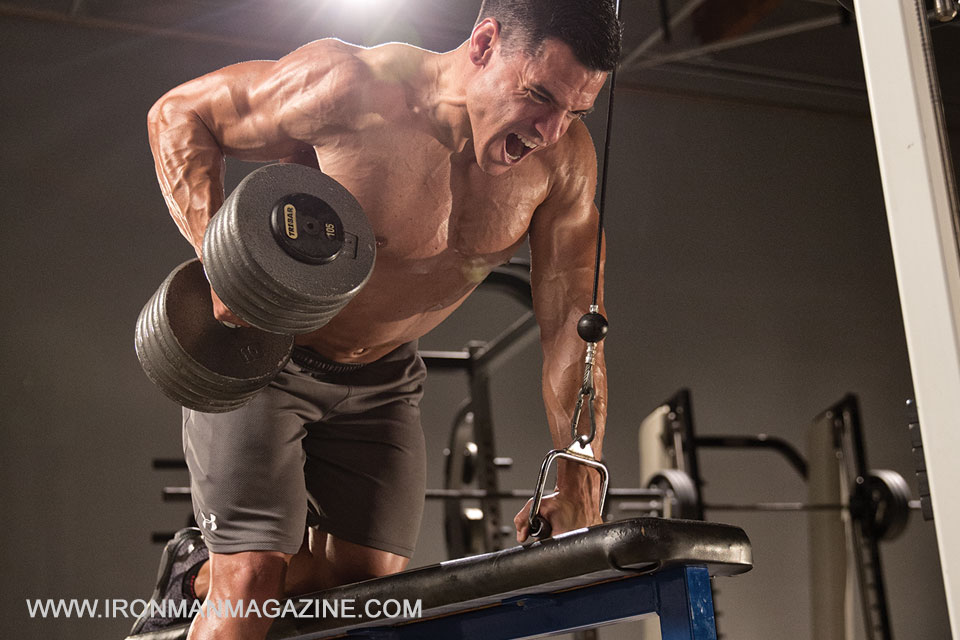


Contralateral Antagonistic Muscle Activation: This is a powerful modern tool for simultaneously hitting a lot of muscle fibers.
If there were a simple way to instantly be 10 percent stronger in an exercise, would you use it? Of course you would! And there is. It’s called Contralateral Antagonistic Muscle Activation (CAMA). The name is long and sounds technical; however, once you understand it, you’ll really see the power behind this technique.
WHAT IT IS
The key concept behind CAMA is this: By activating the antagonistic muscle on the opposite side of the body as the muscle being worked, you can get an instant 10 percent increase in strength in the working target muscle as a result of the increase in nervous system activation.
The physiological mechanism is that approximately 10 percent of the neural fibers that cross over at the medulla oblongata (a part of your brain stem) reciprocally innervate agonist and contralateral antagonist muscles. In simple English, that means that some of the nerves that activate muscle fibers in your left triceps also activate some fibers in your right biceps, and vice versa.
The practical upshot of this is that when you work your right biceps and your left triceps simultaneously, both will see about a 10 percent instant increase in strength due to increased nervous system activation and fiber recruitment. Sound interesting?
EXERCISE CHOICE IS KEY
The trick is finding exercises that can be done simultaneously in an effective manner. Here’s an example. You’re going to be performing a standard one-arm dumbbell row exercise, and at the same time, your support arm is going to be pushing a heavy high-pulley load down onto the bench. Think seesaw.
Now, in the original theory behind this contralateral (seesaw) technique, trainees were advised to use the same tempo for both actions. In our example, however, that’s not practical. You’re just going to be doing an isometric contraction for chest activation. I found it to be just as effective in my testing of the exercise. I have used a simultaneous push/pull for this style of training and, while very effective, I actually found I was limited in the amount of weight I could use by the torque my core was capable of withstanding during the paired exercises. This kind of defeats the purpose of the technique.
HOW TO DO IT
To perform this exercise, you’ll need a bench, a dumbbell, and a high pulley with a single handle. If you don’t have a pulley, you can also use a thick band (or several thinner bands, if that’s all you’ve got).
1) Set the bench so that the end is right beneath the high pulley. Set a moderately heavy weight on the pulley and set a dumbbell you could get about 10 to 12 reps with for rows beside the bench.
2) Get your knee in position on the bench, then grab the cable handle with both hands. Use a powerful downward push with your entire upper body to push the handle down toward the bench. How hard you have to push will depend on how much weight you have on the pulley.
3) Set your fist on the bench, then quickly reach down and grab the dumbbell. Once you pick up the dumbbell, you will have counterbalanced the pull of the pulley weight and you’ll be locked in. Your chest will be in a steady isometric contraction.
4) Get into position for the dumbbell row next. You should have your plant leg out to the side at an angle, knee bent, with an arch in your lower back for support. Look slightly forward to keep a curvature in your neck, which will help you maintain the arch in your lower back. Now simply row. Your plant arm/cable arm does not move. It stays on the bench, right where it is.
5) As you row up, try to consciously push down into the bench with your support arm. which will maximize pec contraction. You will also get massive cross-tension in through your core while performing this technique, so be sure to keep your core tight.
6) Get as many reps as you can, then set the dumbbell down. Grip the cable handle with both hands and bring it back up, setting the stack down (don’t let the handle just fly up and the stack crash down).
7) Mirror the move by repeating on the other side with the same execution pattern.
Sure, this technique is demanding, but it’s very effective. I immediately felt stronger in the exercise the first time I used it. Once you’ve tried it out for moderate to higher reps, try using heavy weight and lower reps as well (if you feel comfortable doing so). Give this one a try next time you hit your back. You’ll feel a little stronger from the very first rep you do, and more strength and more weight means more mass. Plus, the core work is a nice bonus. IM






















You must be logged in to post a comment Login